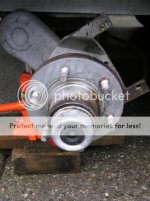Since I had to do this I figured I'd take some pics and write a tutorial for those who've never done anything like it before. I'd say anyone w/ basic tools and a medium mechanical ability can do this themselves. Part numbers are as follows:
Grease seal SL225-1
Bearing race 25520
Inner bearing 25580
Outer bearing cone 15123
Bearing cup 15245
As I noted our trailer is a 2007 King KBT7000B2, w/ disc brakes and "Superlube" spindles.
Please use proper safety precautions like jack stands, blocking the opposing tires etc when working around/under the trailer. The procedure for repacking the bearings follows:
Jack up the trailer and remove the tire/rim. Pull the dust cover/rubber cap off w/ a pair of channel locks. This exposes the outer "axle", castle nut, zirk fitting etc.
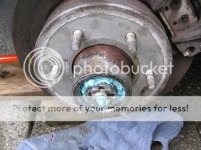
Start by removing the disc brack caliper assembly. This is bolted to the rear of the hub assembly via two 7/16" stud bolts at the back of the caliper. The stud bolts look like this:

Once you've removed both bolts, the entire disc brake caliper will come off. Be careful it doesn't drop on the ground. Don't let it hang via the rubber brake line; I hang mine w/ a piece of wire/hanger like this:
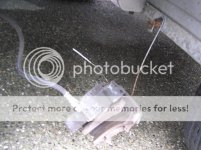
Inspect the pads if they're good move on. Once completed the brake rotor will slide off the studs. Inspect it for gouges/wear etc. Put it aside. You will now have the spindle/hub assembly ready for dissasembly. Holding the castle nut on the axle is a retaining washer w/ two tabs attached. One of the tabs will be bent into one of the notches on the castle nut so it does not loosen. Using a small screwdriver or similiar bend the tab back against the axle so the castle nut can be removed. The order of parts from exterior in is castle nut, retainer wahser, flat washer. Once removed you have this:
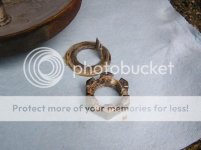
Now the entire hub w/ bearings etc just slides off the spindle. The outer bearing will simply fall/be pulled out.
Hub w/ outer bearing removed:
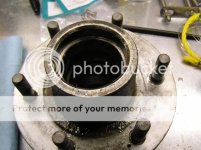
Spindle:
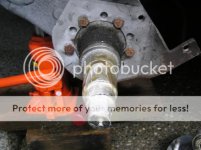
Hub rear w/ grease seal still installed:
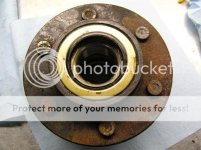
Now to get the seal/inner bearing removed. To do this you'll want to tap it back/out of the hub from the outer side in. I placed it inner-side down on two 4X4's (this creates a space for the seal/bearing to fall) and used a race driver & small hammer. You could use a punch & hammer being careful to tap around the inner bearing evenly & slowly; DON'T JAM THE BEARING IN THE HUB!!! Even, slow tapping/pressure will get it out. Once the seal gives the inner bearing will fall out w/ it. Here's the parts you're now looking at:
New seal and clean bearings;
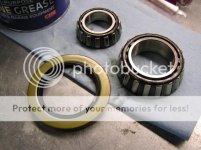
The larger inner bearing/smaller outer bearing after cleaning:
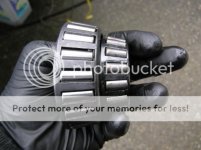
Now the messy part. Clean up all the old grease from all parts. THIS IS ESPECIALLY IMPORTANT IF YOU ARE USING A DIFFERENT COMPOUND OF GREASE! DON'T MIX DIFFERENT BASE GREASES TOGETHER. I switched to an grade 2, aluminum based, Marine grease not a lithium based grease. To clean everything I used solvent, a parts brush and lots of paper towels in a pan. Once clean, I inspected both the races and the bearings for wear, pitting etc. My bearings/races were fine so I re-used them. You may need to replace one or both bearings.
Races were smooth & shiny:

Same w/ the spindle; smooth & shiny:
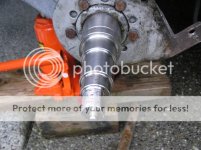
Now repack the bearings. I do the old hand/palm method and I wish I could've taken pics but I was alone. Some of you old time mechanics know this is the best way to repack bearings completely. Basically, put a blob of grease in your weak hand. Grab the bearing w/ the larger side facing down w/ your strong hand. Push, slap the bearing onto your palm like you're knocking on a door, forcing grease up, into & through the bearing. You wanna see it "goosh" out the smaller side.
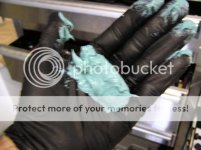
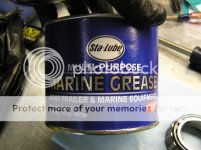
I did the inner bearing first, placed in in the hub
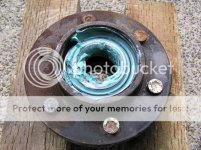
...and placed a new seal over it.
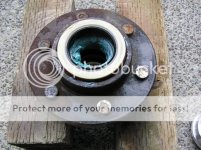
Now tap the new seal into place. I used a bearing driver
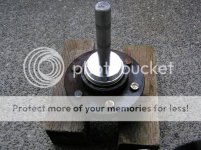
...but it could be done w/ a piece of wood like a 2X4 & a hammer. USE EVEN PRESSURE! You want the seal to go in EVENLY & STRAIGHT and not jam in the hub. Take your time. When the seal is flush w/ the hub it's installed.
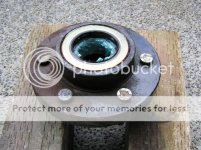
Repack the outer bearing, put it in the hub and place the hub onto the spindle. Place hub on spindle in reverse order as listed above. Rotate the hub while tightening the spindle nut to approximately 50 ft lbs. This translates into full handpressure with a 12” long set of pliers or 12” long wrench. Loosen the spindle nut to remove the torque, do not rotate hub.
Finger tighten the spindle nut until snug, backing out only to line up the locking tang washer. Bend the locking tang tab in place. Replace grease/hub cap. Replace the rotor and caliper. I used red Loctite on teh threads of the two stud bolts that hold the caliper on. Test hub with wheel mounted for excessive play or tightness, re-adjust if required.

Done!
